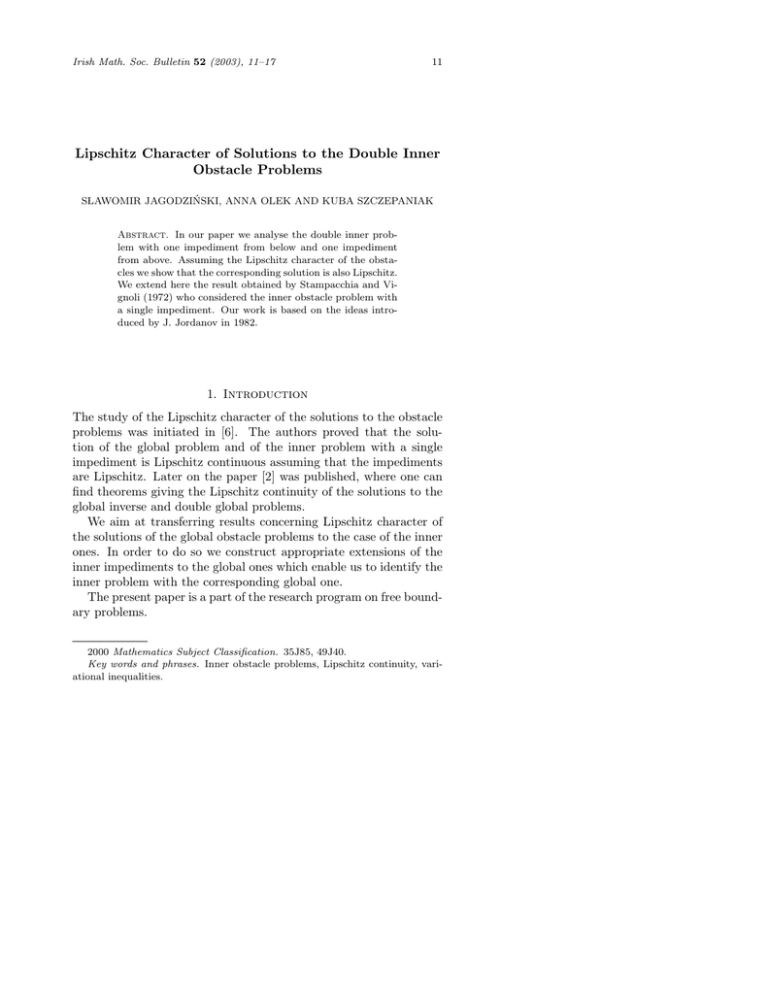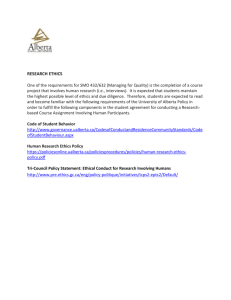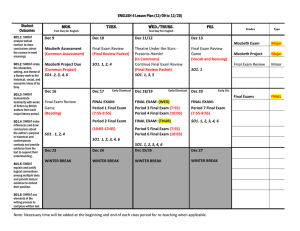Lipschitz Character of Solutions to the Double Inner Obstacle Problems
advertisement

Irish Math. Soc. Bulletin 52 (2003), 11–17
11
Lipschitz Character of Solutions to the Double Inner
Obstacle Problems
SÃLAWOMIR JAGODZIŃSKI, ANNA OLEK AND KUBA SZCZEPANIAK
Abstract. In our paper we analyse the double inner problem with one impediment from below and one impediment
from above. Assuming the Lipschitz character of the obstacles we show that the corresponding solution is also Lipschitz.
We extend here the result obtained by Stampacchia and Vignoli (1972) who considered the inner obstacle problem with
a single impediment. Our work is based on the ideas introduced by J. Jordanov in 1982.
1. Introduction
The study of the Lipschitz character of the solutions to the obstacle
problems was initiated in [6]. The authors proved that the solution of the global problem and of the inner problem with a single
impediment is Lipschitz continuous assuming that the impediments
are Lipschitz. Later on the paper [2] was published, where one can
find theorems giving the Lipschitz continuity of the solutions to the
global inverse and double global problems.
We aim at transferring results concerning Lipschitz character of
the solutions of the global obstacle problems to the case of the inner
ones. In order to do so we construct appropriate extensions of the
inner impediments to the global ones which enable us to identify the
inner problem with the corresponding global one.
The present paper is a part of the research program on free boundary problems.
2000 Mathematics Subject Classification. 35J85, 49J40.
Key words and phrases. Inner obstacle problems, Lipschitz continuity, variational inequalities.
12
Slawomir Jagodziński, Anna Olek and Kuba Szczepaniak
2. Notation and Basic Definitions
Throughout the paper we assume that Ω ⊂ Rn is an open, bounded
set with smooth boundary ∂Ω. The functions aij : Ω̄ → R for
1 ≤ i, j ≤ n belong to C 1 (Ω) and satisfy the ellipticity condition, i.e.
there exist γ, µ > 0 such that
µ|ξ|2 ≥ aij (x)ξi ξj ≥ γ|ξ|2
for x ∈ Ω and ξ ∈ Rn ,
(1)
where the summation convention is adopted. We also introduce the
second order elliptic operator
¡
¢
L = −∂xi aij (x)∂xj .
(2)
Remark 2.1. The operator L defined by (2) considered as the mapping L : H01 (Ω) → H −1 (Ω) defines a bilinear, continuous and coercive form on H01 (Ω) as follows (see [5]):
Z
a(u, v) = hLu, vi =
aij (x)uxi (x)vxj (x) dx (u, v ∈ H01 (Ω)). (3)
Ω
Now we pass to the precise definitions of fundamental concepts of
this work.
Let us consider a function Ψ1 ∈ H 1 (E), where E is a compact
set such that E ⊂ Ω and ∂E is smooth. Next we take a function
Φ1 ∈ H 1 (F ), where F is a compact set such that F ⊂ Ω and ∂F is
smooth. Moreover, we assume that:
Ψ1 ≤ Φ1
We denote by
K11
K11
on E ∩ F.
(4)
the following admissible set:
= {v ∈ H01 (Ω) : v ≥ Ψ1 on E ∧ v ≤ Φ1 on F }.
Definition 2.2. For the form defined by (3) and f ∈ H
problem:
Find u11 ∈ K11 such that
a(u11 , v − u11 ) ≥ hf, v − u11 i
for any v ∈ K11 ,
−1
(5)
(Ω) the
(6)
K11
is defined by (5) is called a double inner obstacle problem
where
with the impediments Ψ1 and Φ1 .
In what follows we shall use the notation DIP to denote the double
inner obstacle problem.
Remark 2.3. If we take E
¯ = F = Ω¯ and assume that Ψ1 = Ψ and
Φ1 = Φ are such that Ψ¯∂Ω ≤ 0, Φ¯∂Ω ≥ 0 and Ψ ≥ Φ then Definition 2.2 gives the definition of the double global obstacle problem
Solutions to the Double Inner Obstacle Problems
13
with the impediments Ψ and Φ. The admissible set will be denoted
by K̃11 . We shall use the notation DGP to denote the double global
obstacle problem.
The existence and uniqueness theorem for DGP can be found
in [5].
3. Lipschitz Regularity
In this section we present the main result of our paper, i.e., the
Lipschitz regularity of the solution of DIP . We start with recalling
the following lemma (see [6], [2]).
Lemma 3.1. The solution ũ11 of DGP with the impediments Ψ and
Φ is Lipschitz (ũ11 ∈ H 1,∞ (Ω)) provided Ψ, Φ ∈ H 1,∞ (Ω).
In the proof of the following theorem our ideas are based on equivalence of the inner problem with the corresponding global one.
Theorem 3.2. If the functions Ψ1 ∈ H 1,∞ (E), Φ1 ∈ H 1,∞ (F )
satisfy
Ψ1 ≤ Φ1 in E ∩ F,
(7)
1
then there exists a unique solution u1 to DIP with the impediments
Ψ1 , Φ1 and f being equal to zero. Moreover, this solution is Lipschitz
continuous.
Proof. Let us construct the function Ψ̄1 : Ω → R in the following
way
½
w1 in Ω \ E
Ψ̄1 =
(8)
Ψ1 in E,
where w1 ∈ H 1 (Ω \ E) solves the problem
Lw1 = 0 in Ω \ E
w1 = Ψ1 in ∂E
(9)
w1 = 0
in ∂Ω.
Next in a similar way we construct the function Φ̄1 : Ω → R.
½
w2 in Ω \ F
Φ̄1 =
Φ1 in F,
where w2 ∈ H 1 (Ω \ F ) solves the problem
Lw2 = 0 in Ω \ F
w2 = Φ1 in ∂F
w2 = 0
in ∂Ω.
(10)
(11)
14
Slawomir Jagodziński, Anna Olek and Kuba Szczepaniak
It is well known (see [5]) that in order to show existence and uniqueness of the solution u11 of DIP it is enough to show non-emptiness of
the set K11 . Let us note that max{Ψ̄1 , 0} + min{Φ̄1 , 0} ∈ K11 which
yields the desired conclusion.
Now we proceed to regularity of the solution. We shall construct
two Lipschitz functions Ψ and Φ such that the solution ũ11 ∈ K̃11 of
DGP with the impediments Ψ and Φ and the force f being equal to
zero will coincide with the solution u11 of DIP .
Let us consider the coincidence set I[u11 ] for DIP . Obviously it is
contained in E ∪ F (as (7) holds). We denote by IF [u11 ] that part of
I[u11 ] which is contained in F ∩ (Ω \ E) where u11 = Φ1 and by IE [u11 ]
that part of I[u11 ] which is contained in E ∩ (Ω \ F ) where u11 = Ψ1 .
Now we put
½
Ψ̄1
in E
(12)
Ψ̃1 =
min{Ψ̄1 , Φ̄1 } in Ω \ E,
½
Φ̄1
in F
Φ̃1 =
(13)
max{Ψ̄1 , Φ̄1 } in Ω \ F.
Both functions Ψ̃1 and Φ̃1 are continuous. Moreover, they are both
Lipschitz.
Now let us take a Lipschitz function ξ ∈ H01,∞ (Ω) such that
ξ|∂(Ω\E) = 0 and ξ < 0 in Ω \ E. Next we consider the Lipschitz
function δ ∈ H 1,∞ (Ω) where we put δ = Ψ̃1 + ξ. We know that
u11 = Φ1 = Φ̃1
in IF [u11 ].
(14)
It also satisfies
u11 > δ = Ψ̃1 + ξ
in IF [u11 ]
(15)
IF [u11 ].
From the continuity
since Ψ̃1 + ξ = min{Ψ̄1 , Φ̄1 } + ξ < Φ̃1 in
of u11 , ξ and Ψ̃1 we state that there exists a neighbourhood OF of
IF [u11 ] where the inequality (15) holds.
Now we choose a set DF with the smooth boundary in the following way:
IF [u11 ] ⊂ DF ⊂ D̄F ⊂ OF ∩ (Ω \ E).
Let ψ be the solution of the problem:
½
Lψ = 0 in (Ω \ E) \ D̄F
(16)
ψ=δ
in ∂((Ω \ E) \ D̄F ).
The function ψ is Lipschitz. Next we remark that the set D was
chosen in such a way that (Ω \ E) \ D̄F ⊂ Ω \ I[u11 ]. Therefore using
Solutions to the Double Inner Obstacle Problems
15
again the basic properties of the solutions to the obstacle problems
(see [5]) we have that Lu11 = 0 in (Ω \ E) \ D̄F . Hence
L(u11 − ψ) = 0
in (Ω \ E) \ D̄F .
Moreover, we have
u11 = ψ = Ψ̄1
in ∂Ω,
it follows from definition of Ψ̄1 and the constructions of Ψ̃1 and ξ,
u11 ≥ ψ = Ψ̄1
in ∂E,
it follows from (7) and the constructions of Ψ̃1 and ξ,
u11 ≥ ψ
in ∂DF ,
it follows from (15) and the construction of the set DF . Then the
maximum principle implies that
u11 ≥ ψ
Finally we put
Ψ1
δ
Ψ=
ψ
in (Ω \ E) \ D̄F .
in E
in D̄F
in (Ω \ E) \ D̄F .
(17)
(18)
Clearly the function Ψ is Lipschitz continuous in Ω. Moreover,
u11 ≥ Ψ
in Ω
(19)
since u11 ∈ K11 , (17) holds and (15) is satisfied in DF ⊂ OF ∩ (Ω \ E).
Now we pass to the remaining part of the proof. We choose a Lipschitz function η ∈ H01,∞ (Ω) such that η > 0 in Ω \ F and η|∂(Ω\F ) =
0. Next we consider the Lipschitz function σ ∈ H 1,∞ (Ω) where we
put σ = Φ̃1 + η. We know that
u11 = Ψ̃1 = Ψ1
in IE [u11 ].
(20)
It also satisfies the following:
u11 < σ = Φ̃1 + η
in IE [u11 ]
(21)
as Ψ̃1 = Ψ1 < Φ̃1 + η in IE [u11 ]. From the continuity of u11 , η and Φ̃1
we state that there exists a neighbourhood OE of IE [u11 ] where the
inequality (21) holds. Acting similarly as above we can choose a set
DE with the smooth boundary such that:
IE [u11 ] ⊂ DE ⊂ D̄E ⊂ OE ∩ (Ω \ F ).
16
Slawomir Jagodziński, Anna Olek and Kuba Szczepaniak
Denoting by φ the solution of the problem
½
Lφ = 0 in (Ω \ F ) \ D̄E
φ=σ
in ∂((Ω \ F ) \ D̄E ),
(22)
we get that φ is Lipschitz provided σ is Lipschitz. Knowing that
(Ω \ F ) \ D̄E ⊂ Ω \ I[u11 ] and using the maximum principle we deduce
that:
u11 ≤ φ in (Ω \ F ) \ D̄E .
(23)
Finally we put
Φ1 in F
σ
in D̄E
Φ=
(24)
φ
in (Ω \ F ) \ D̄E .
The function Φ is Lipschitz. Moreover,
u11 ≤ Φ
in Ω
(25)
as u11 ∈ K11 , (23) holds and (21) is satisfied in DE ⊂ OE ∩ Ω \ F .
Let us now denote by ũ11 the solution of DGP with the impediments Ψ, Φ given by (18), (24), respectively and the force f being
equal to zero. Conditions (19), (25) together with u11 ∈ H01 (Ω) imply
that u11 ∈ K̃11 . Thus we can state
a(ũ11 , u11 − ũ11 ) ≥ 0.
It is also true that
a(u11 , ũ11 − u11 ) ≥ 0
because u11 ∈ K11 solves the variationally inequality (6) with f = 0
and ũ11 ∈ K̃11 ⊂ K11 . After adding the last two inequalities we shall
obtain (using coercivity of the form a(·, ·) in H01 (Ω)) that there exists
ν > 0 such that
ν k ũ11 − u11 k2 ≤ a(ũ11 − u11 , ũ11 − u11 ) ≤ 0,
which implies that ũ11 = u11 in Ω. The Lipschitz continuity of ũ11 (see
Lemma 3.1) completes the proof.
¤
Remark 3.3. In this work we examine the Lipschitz regularity of the
solution of the double inner problem. Its natural generalisation is
the inner obstacle problem with l > 1 impediments from below and
m > 1 from above. The main problem is to find appropriate extensions of the inner obstacles, which allow us to identify the solution
of the inner problem with the solution of the corresponding global
one.
Solutions to the Double Inner Obstacle Problems
17
Remark 3.4. It is well known that in case of solutions of the global
problems one can expect their regularity up to H 2,p . For the inner problem the situation is much more complicated. Despite H 2,p
regularity of the obstacle the same class of the solution can not be
obtained. However under certain assumptions it is possible to get
H 2,p regularity of the solutions (see [1], [3]).
References
[1] J. Baniasiak, K. Szczepaniak, On regularity of solutions to inner obstacle
problems, ZAA (1993), 401 – 404.
[2] M. Chipot, Variational inequlities and flow through the porous media,
Springer Verlag 1984.
[3] S. Jagodziński, A. Olek, K. Szczepaniak, Inner obstacle problems: regularity
of solutions and continuous dependence on obstacles, to appear.
[4] J. Jordanov, Solutions holderiennes d’inequations variationelles à contraines discontinuons, Serdica, 8 (1982), 296 – 306.
[5] D. Kinderlehrer, G. Stampacchia, An introduction to variational inequalities
and their applications, Academic Press, 1980.
[6] G. Stampacchia, A. Vignoli, A remark for a second order nonlinear differential operator with non-Lipschitz obstacles, Boll. Un. Mat. Ital. 5 (1972),
123 – 131.
SÃlawomir Jagodziński, Anna Olek, Kuba Szczepaniak
Department of Mathematics,
Technical University of L
à odz,
ul. Zwirki 36,
PL–90-924 L
à odz, Poland
slawjago@p.lodz.pl
annaolek@ife.p.lodz.pl
kubaszcz@ife.p.lodz.pl
Received on 3 October 2003 and in revised form on 12 March 2004.






